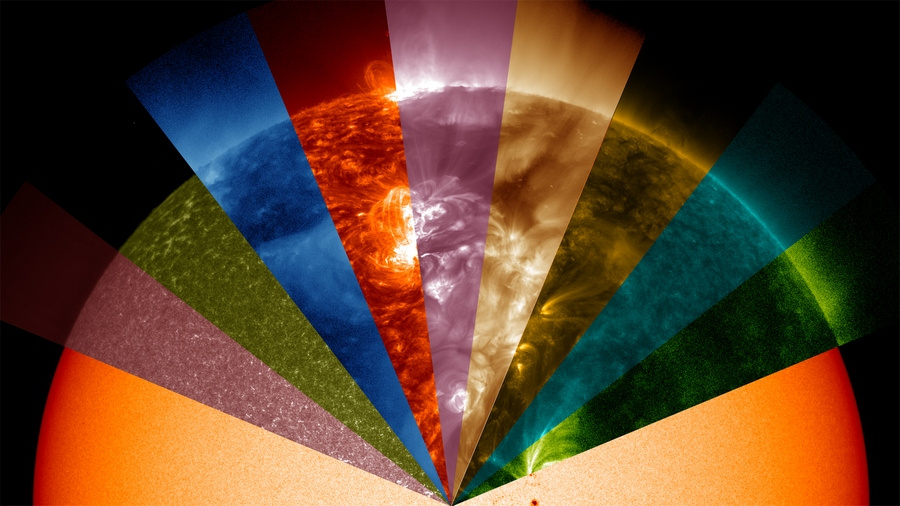
The night from the 1st to the 2nd of September 1859 marked itself as the largest aurora, in the entire history of astronomical observations - it could be observed throughout the entire territory of the Earth. In the circumpolar regions, with its light it was possible to read, it was so bright - that it woke the miners in the
Rocky Mountains . Most of the telegraphs in Europe and North America are out of order, and on the telegraph poles - witnesses observed sparks. Evaluation of the consequences of such an event (if it happens in the modern world, with centralized electrical networks) gives damage values of 0.6-2.6 trillion $,
only for the USA . Such was the most destructive manifestation of space weather at the moment, recorded by mankind.
In the first part of the article - I will describe the phenomena of solar activity that underlie the
“space weather” , and for this, in turn, we will need to delve into the structure of the Sun, which looks like this:
 The solar core
The solar core - occupies a zone from the center to 0.25 of the radius of the sun. Here is a zone with a maximum temperature (about 15 million K), pressure (about 250 billion atmospheres), and density (reaching 150 g / cm
3 ). Since the rate of thermonuclear reactions strongly depends on temperature - the main part of the energy release in the sun, it is in this region that occurs. However, even with such indicators - the rate of thermonuclear reactions is not very high (about 275 watts / m
3 ), therefore thermonuclear reactors, such as
ITER - require
an order of magnitude greater temperatures
in order to have reasonable indicators in terms of volume / power.
The radiative transfer zone extends from a depth of 0.25 to about 0.7 times the radius of the sun. It is called so - because the main method of energy transfer in it is the sequential emission and absorption of photons. This is a rather calm zone in which the main type of movement is rotational: the Sun makes about one revolution in 25.6 days along the equator line (for an observer on Earth, taking into account our rotation around the Sun, it goes out approximately 28 days), and for 33.5 day at the pole level. The radiant zone, in this case, has an approximately average (between these two) speeds.
Tachoclin is a transition region located between the radiant and convective zones, its thickness is approximately 0.04 of the Sun's radius. In this area, there is a transition from radiant (quiet) heat transfer to convective (turbulent), and from "solid-state rotation" (when the layers rotate at a uniform frequency) - to the differential (differing in polar and equatorial regions).
The reasons for this transition are as follows: at the border of about 0.7 times the radius of the sun - a gradual drop in temperature and pressure of the solar layers leads to the fact that physical conditions no longer allow plasma atoms to be sustained without electrons (hydrogen atoms once ionized and helium twice). Accordingly, the
photoelectric effect begins to act, and the substance ceases to be transparent. Radiant transfer loses its efficiency, and convective heat transfer comes first.
The explanation of the source of the second effect is a much more complex task, and its solution was not given to scientists for a long time. But in 2013, using data from
the Solar Dynamics Observatory , the connection between convective motion on the Sun (which is chaotic on small scales) and stable,
differential rotation of the Sun was also
shown :
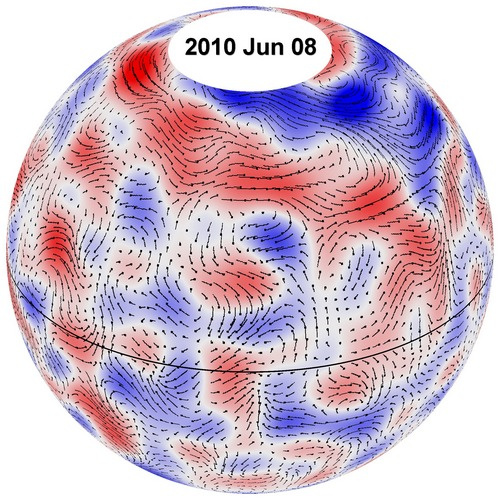
The key factors in understanding the processes occurring on the Sun are as follows:
1) The source of energy for the emergence of all the processes recorded by us on the Sun is turbulent convection (and its source is the temperature gradient between the solar core, in which thermonuclear reactions take place, and the surface of the Sun through which this energy is emitted).
2) Practically all matter on the Sun (with the exception of a certain fraction of hydrogen in the photosphere) is in a state of
plasma . For this reason, energy transfer occurs at the expense of the kinetic energy of convective currents, and at the expense of the
electromagnetic field . At the same time, energy can freely transfer from one type to another (plasma movement can generate a magnetic field, and in another case, a magnetic field can accelerate plasma flows).
Convective zone - a zone located at a distance of about 0.7 radius, and directly to the most visible surface. In the absence of other possibilities, heat transfer from this level begins to occur due to the mixing of the layers (that is, convection, which is why this zone itself was named so). This zone is responsible for all the phenomena that are called
"solar activity" .
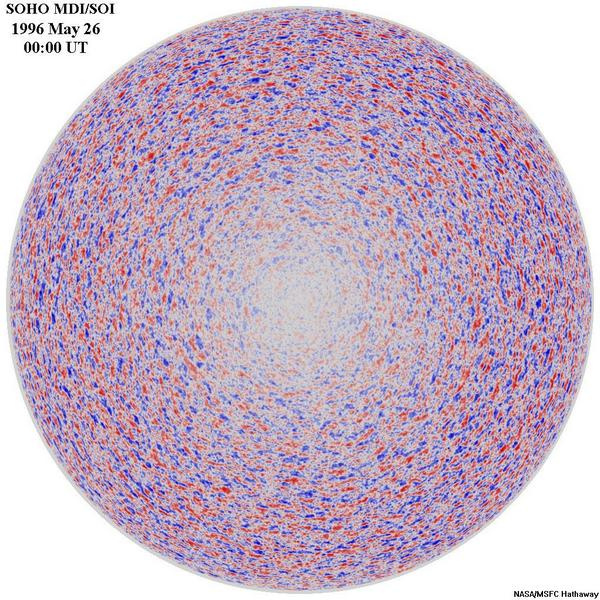
The basic structure of the convective zone (and the visible "surface" of the Sun) - consists of
granules (typical diameter is 1000 km, and the lifetime is from 8 to 20 minutes), and
supergranules (30 thousand km in size, and life time is about 24 hours) . Granular structure - consists of bright areas (where the substance rises from the depths of the Sun) and dark gaps between them (where the substance falls, respectively). The vertical speed of a substance is 1-2 km / s, and the depth of the granules is hundreds and thousands of kilometers.
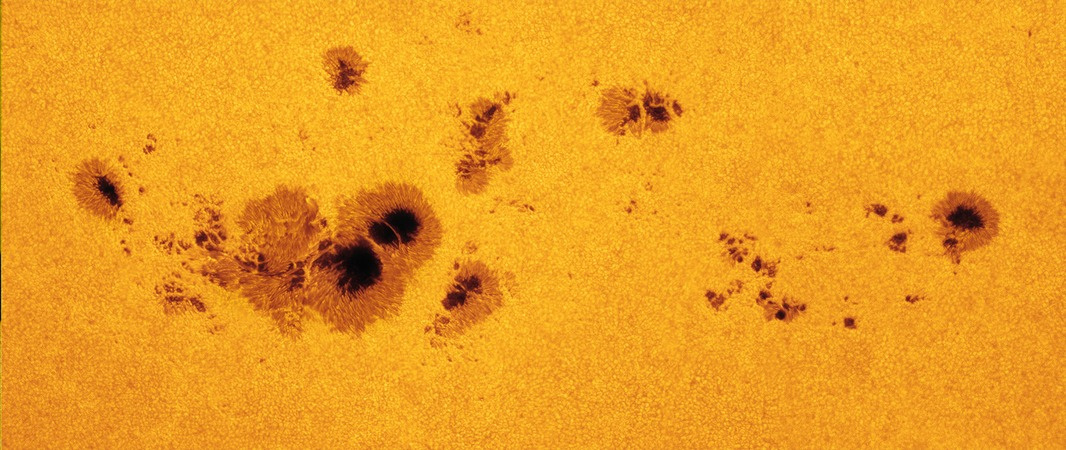 Sunspots
Sunspots are areas in which strong magnetic fields impede the convective movement of matter. In spite of the name, they can be called “spots” with a big stretch: the temperature inside them is 3000-4500 K. And their visible blackness is explained by the temperature of the surrounding substance (averaging 5780 K), and, accordingly, the much lower emission of light by “spots” external background. Practically from the beginning of systematic observations of sunspots in 1749 - they became the main evidence for the existence of an
11-year cycle of solar activity (therefore, the one that was running at that moment — it started in 1745) was chosen as the zero cycle:
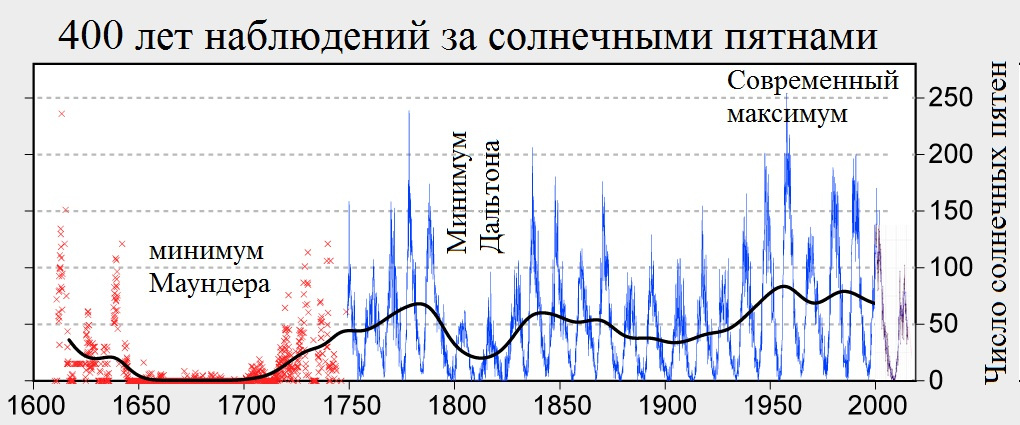
To be more precise, the cycle has an average duration of about 11.2 years, and varies in the range from 7 to 17 years (and the shorter the cycle is, the more power it has). The growth stage in the cycle takes a shorter period of time (4.6 years, versus 6.7 years - on average, at the recession stage). At the beginning of the cycle, sunspots appear at latitudes of the order of ± 35-40 °, then shift to an area of ± 15 ° during the maximum period, and by the end of the cycle - most of them occur at latitudes of ± 5-8 ° (the so-called
Spörer law ):

Such cycling in the behavior and the number of spots is associated with an 11-year cycle for changing the magnetic poles of the Sun (with a full cycle for changing the polarity of north / south - it takes 22 years, respectively). However, this 22-year period (
the Hale cycle ) was not widely known, since, apart from changing polarity, it practically does not manifest itself.
The availability of statistics for 400+ years suggested the existence of a century-old solar activity cycle (the so-called Gleissberg cycle - lasting in the range of 70-100 years, with an average value of 87 years). But to truly prove its existence - it was possible only with the advent of radiocarbon analysis: the fact is that during periods of solar maximum the solar wind becomes denser, and the solar
heliosphere expands a bit (this was the basis of reports of Voyager-1 out of the solar system:
1 ,
2 ,
3 ,
4 ), while the flow of
galactic cosmic rays is reduced, and with it the production of radioactive
carbon-14 in the upper atmosphere is reduced. The traces of these changes over the past 11 thousand years are found in
ice cores and
tree rings :
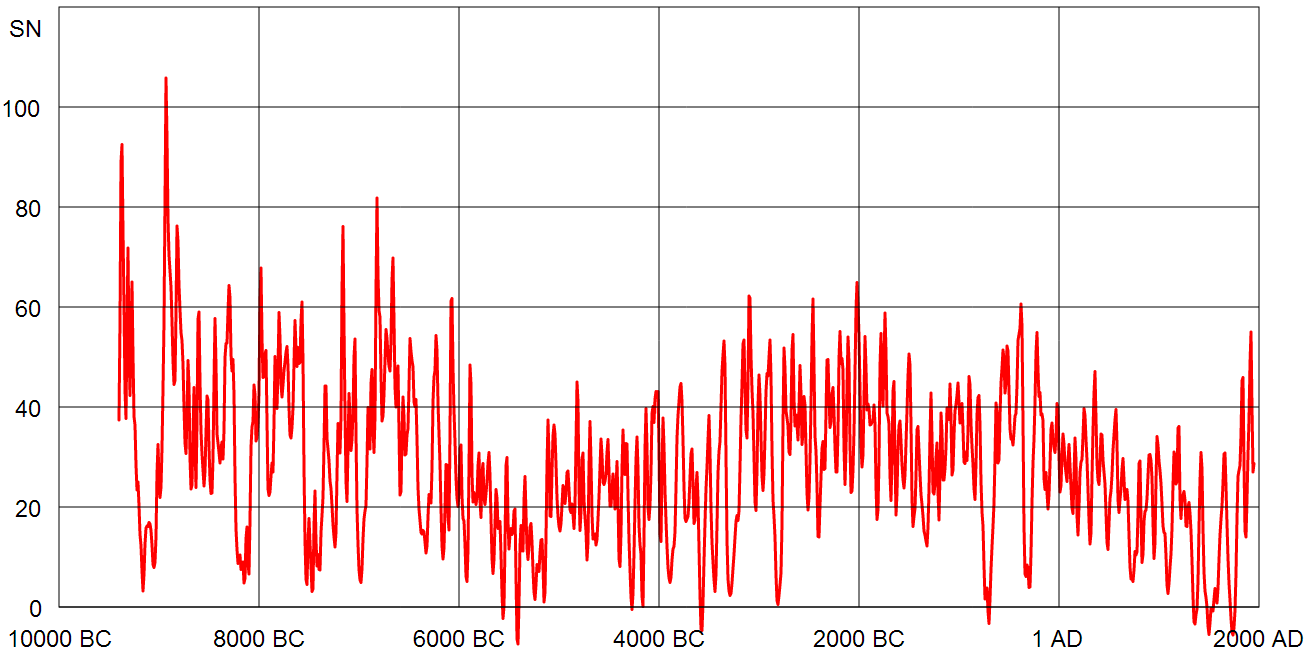
Sunspots are often formed in groups, with the leading spot having the same polarity as the current polarity of the hemisphere, and the backward opposite one. A group of spots may exist from several hours to several months (a long-term, 27-day forecast is based on this — when spots that have made one revolution return to the same position as they are now).
Solar torches are peculiar “spots per revolution”: in this case the magnetic field acts as an amplifier of convection, which in turn raises the temperature and luminosity of the “surface” of the Sun.
The protuberances are formations of a bizarre form, in a stable state resembling a half of a
torus , resting on the "surface" of the Sun:
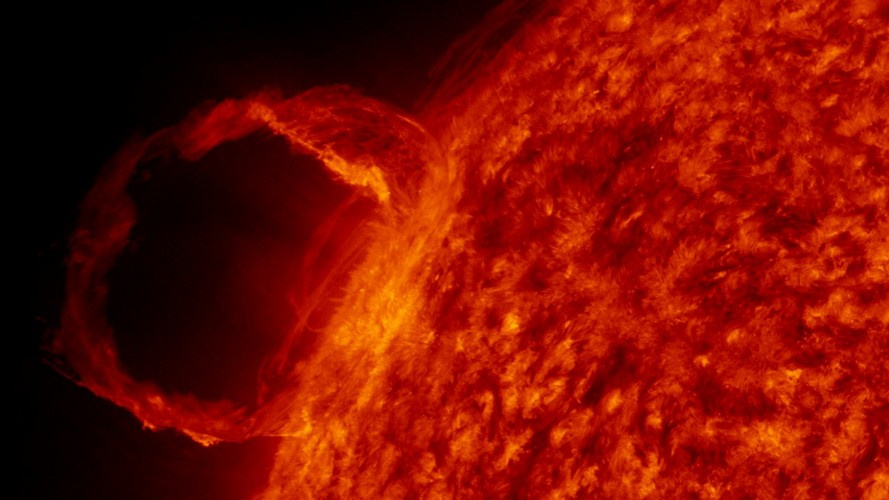
This form is due to the magnetic field, which is their source: a stream of matter moving along magnetic lines - at the beginning rises from the depths of the Sun, then describes an arc, and falls back to the Sun. Such fountains of substance - can exist up to months. They can be huge energy, which can be released in two physical phenomena, which will be discussed below.
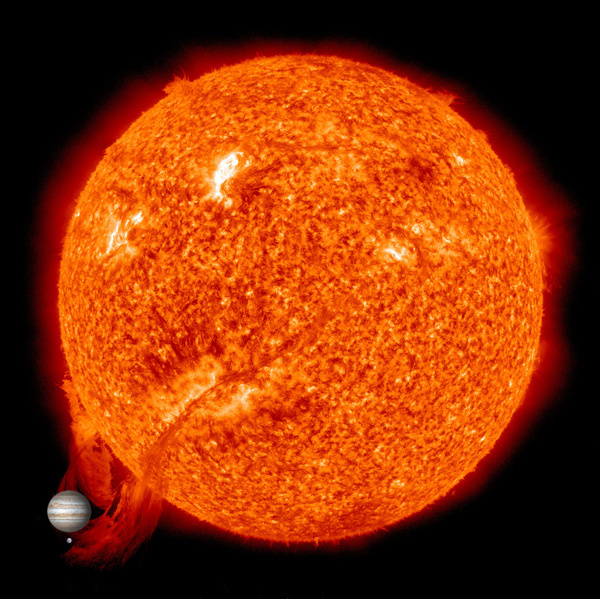
The sun, a large prominence and Jupiter with the Earth - in scale
Solar flares are gigantic emissions of energy (the largest of which is described at the beginning of this article). During a typical flare, energy can be released on the order of 10
20 J (about 10 gigatons in TNT equivalent), in large - about 10
25 J (about 1 billion megatons). Their source is the
reconnection of magnetic fields on the Sun (when two magnetic "rings" are in contact with each other, and drastically change their structure):
Accurate evidence of such a process was obtained
quite recently . During a solar flare, energy is released in the entire spectrum of electromagnetic radiation, most of it is emitted in a hard ultraviolet, as well as x-rays and gamma rays (this is due to the fact that magnetic fields in the process of reconnection heat the plasma to tens of millions of degrees). Only a small part of the energy is emitted in the visible range of light, so in the usual situation - they are not visible. But in the case of the
Carrington event - a flash could be observed even with the naked eye.
The intensity of the flashes is divided into five classes: A, B, C, M, X. Each succeeding class is ten times more powerful than the previous one. Each class is divided into a linear scale from 1.0 to 9.9, the class X does not have an upper limit: at the moment the most powerful flash recorded since 1957 (when extraatmospheric observations began, and the full power over the entire emission spectrum became possible to establish)
November 4, 2003 , and according to updated data - had a class X45.
| Flash class | Intensity in gamma rays 0.5-8 Å, W \ m 2 |
|---|
| A | up to 10 -7 |
|---|
| B | from 10 -7 to 10 -6 |
|---|
| C | from 10 -6 to 10 -5 |
|---|
| M | from 10 -5 to 10 -4 |
|---|
| X | more than 10 -4 |
|---|
Coronal mass ejection is an accompanying flare-up (but not always), a process of ejecting huge masses of matter (as reflected in the name of this process). On average, emissions are about a billion tons, and flow at high speed (about 500 km / s). The source of such masses is the prominences. In the process of reconnection of the magnetic field, the magnetic lines rush from the Sun to infinity, behind them - the masses of plasma rush along them:
The latest
computer models with high accuracy describe the processes occurring on the Sun - this allows us to hope that soon a period of accurate forecasts for space weather can be obtained not in 3 days - but over a period considerably longer.
Comparison of the model with real coronal ejection The photosphere is the visible "surface" of the sun. It is approximately 300 km in thickness, and it is in it that most of the visible spectrum is emitted. The density of this layer is from 10
-8 to 10
-9 g \ cm
3 . It is here that the minimum temperature of the Sun (4300 K) is reached, but the average temperature of this region is close to a temperature of 5777 K:
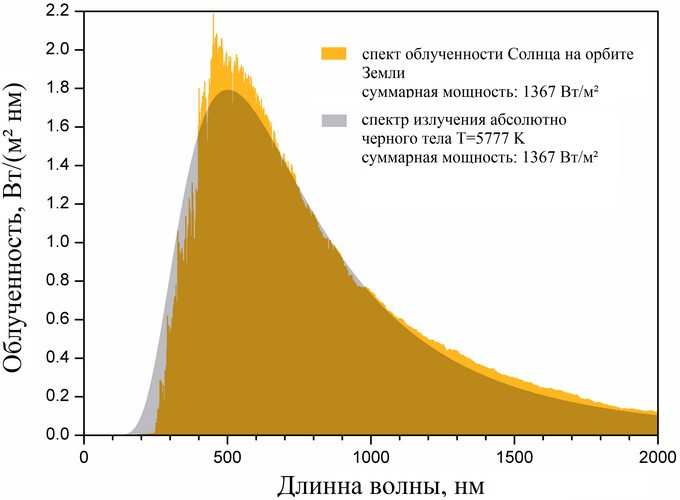
In fact, being a continuation of the convective zone - the photosphere is visible (for us) a reflection of those phenomena and the structure that exists in the convective zone (which is described above).
The chromosphere is a layer about 10 thousand km thick, located between the photosphere and the corona. Here the pressure starts to drop sharply, and the temperature starts to rise again:
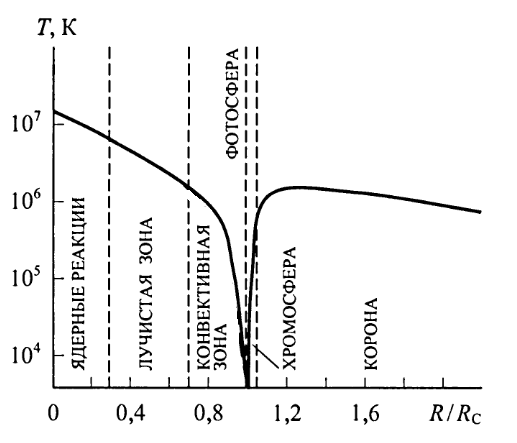
Due to the fact that the pressure in this layer is very low - its luminosity (despite the rise in temperature) is hundreds of times less than that of the photosphere. For this reason, it was first discovered due to lunar eclipses (when the light from the photosphere did not interfere with the observation of this layer). It was in this region of the Sun that helium was first discovered.
The chromosphere mainly consists of spicules - objects of oblong shape, having several thousand kilometers in diameter, and about a thousand in depth:
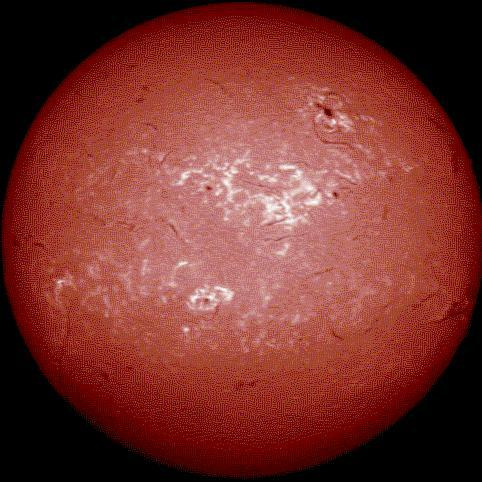
Rising from the photosphere - they transfer matter to the upper layers of the sun. Another component of the chromosphere is fibrils. They are vertical loops of matter, carried away by a magnetic field (by the type of prominences).
Crown - starts from the apparent radius of the Sun, and extends to 10-20 of its diameter. It consists of a very rarefied and unevenly distributed substance, with a temperature in excess of one million kelvin.

The source of such a high temperature of the corona, according to the
latest data , is chromospheric spicules, which feed it with high-energy particles. The structure of the corona strongly depends on the period of solar activity: at the time of the maxima, it has a spherical shape;
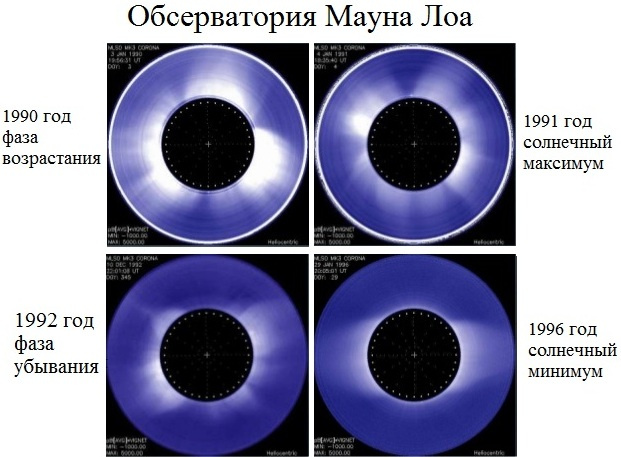 The solar wind
The solar wind is a stream of highly rarefied solar matter, with a temperature close to the coronal, moving at high speed (on the Earth’s orbit - its speed is 300-400 km / s):
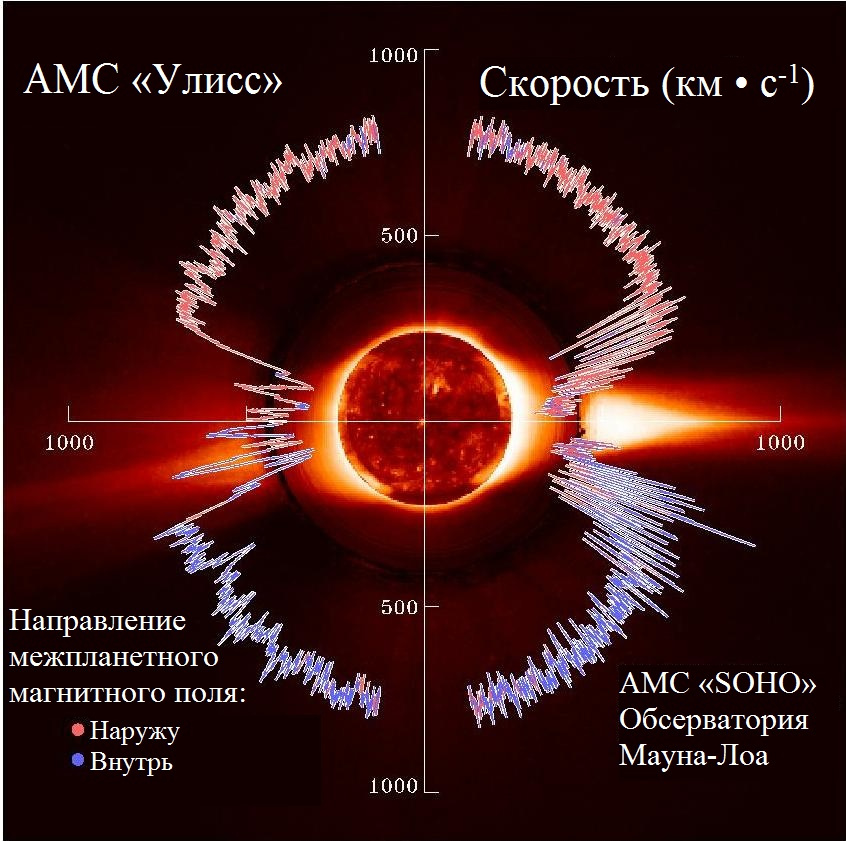
This substance is accelerated by the magnetic fields of the sun (from this such a high difference in speed between the equator and the poles). The pressure they produce is 1-6 nPa in the Earth's orbit (depending on the period of the 11-year cycle and the presence of coronal emissions). Through the solar wind - the Sun loses about 10
-14 M
C (this is several orders of magnitude less than what it loses due to radiation).
P.S. In the second part of the article - about the space weather, the devices exploring the Sun and services that monitor its condition.